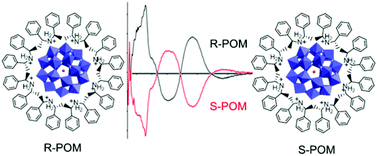Induced circular dichroism of polyoxometalates via electrostatic encapsulation with chiral organic cations†
Abstract
To explore the principle of chiral induction in inorganic clusters, chiral organic cations with two stereocenters, R- and S-BPEA, are used to encapsulate a series of polyoxometalates (POMs) bearing different structures and transition absorption bands in aqueous solution, constructing a series of chiral supramolecular complexes. Due to the induction of chiral organic cations, POMs possessing both chiral and achiral structures show an induced circular dichroism (ICD) effect. ICD signals in the absorption bands corresponding to ligand to metal charge transfer (LMCT) transitions, d–d transitions and intervalence charge transfer (IVCT) transitions are observed for different complexes. Moreover, the ICD of the POMs exhibits a direct correlation with the degree of POM distortion and the distance between the chiral center and the POM surface. The encapsulation of POMs with chiral organic cations via electrostatic interactions provides a facile and effective method for constructing optically pure POM-based materials.


 Please wait while we load your content...
Please wait while we load your content...